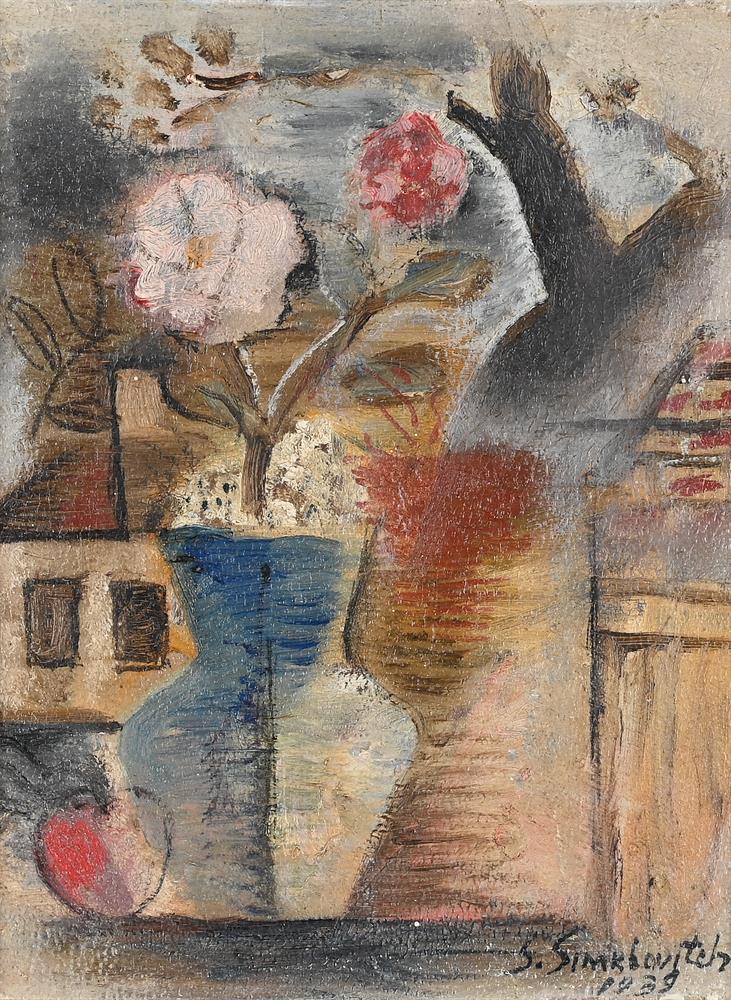SIMKHA SIMKHOVITCH (AMERICAN/RUSSIAN 1893-1949) STILL LIFE AND HOUSES
Couldn't load pickup availability
SIMKHA SIMKHOVITCH (AMERICAN/RUSSIAN 1893-1949)
STILL LIFE AND HOUSES
Oil on board
Signed and dated 1939 (lower right)
19.5 x 14.5cm (7½ x 5½ in.)
Born in the city of Novozybkov in June of 1885, Simka Faibusovich Simkhovitch was a Russian artist. In 1905, Simkhovitch started studying at the Grekov Odessa Art School, one of the oldest art schools in the Ukraine. Upon his graduation in 1911, he received a recommendation for admittance to the Imperial Academy of Arts in Saint Petersburg, which was considered a notable honour at that time.
Though he began courses in architecture, sculpture and painting, Simkhovitch was dismissed from the Imperial Academy in December of 1911 due to the quota on Jewish students and was drafted into the army. Like many others, Simkhovitch was caught in the chaos of the Russian Revolution in 1917; however, he survived and continued his work under the new Soviet government.
In 1918, Simka Simkhovitch exhibited paintings and sculptures in an exhibition of Russian Jewish artists and, in 1919, placed first in “The Great Russian Revolution” competition with his painting “Russian Revolution”. This painting was added to Saint Petersburg’s historical State Museum of Revolution’s collection. Two years later, he travelled to the United States for the purpose of illustrating Soviet textbooks, however, once in the country, he made the decision to immigrate and remain in New York City.
Initially supporting himself by portrait commissions and commercial art, Simkhovitch was hired to paint a theatrical screen for the play “The Command to Love” which was playing at Broadway’s Longacre Theatre. This started his career as a screen painter for the theatre and brought him to the attention of screenwriter Ernest Pascal, known for his screenplay of “The Hound of the Baskervilles”, who gave him work as an illustrator. Pascal, in turn, introduced Simkhovitch to gallery owner Marie Sterner who purchased two paintings and held solo exhibitions of his work at her gallery in 1927 and 1928. These shows were followed by a solo exhibition of his circus paintings, also at the Marie Sterner Gallery, in 1929.
Simka Simkhovitch moved in the early 1930s with his wife, Elsa, and his three daughters to Conneticutt where he established a studio in his house. There he continued to produce works by commission during the Great Depression years. After a solo exhibition at New York City’s Helen Hackett Gallery in 1931, Simka Simkhovitch became one of the featured artists at the 1931 exhibition held at San Fransisco’s California Palace of the Legion of Honour located in Lincoln Park. Coordinated by Marie Sterner, the exhibition featured four of Simkhovitch’s watercolours, including his “Nudes”, now in a private collection.
Beginning in 1936, Simkhovitch began working with the Works Progress Administration, WPA, painting murals for public buildings in the United States. His first work was a 1938 mural for the Jackson, Mississippi, post office and courthouse. Painted on the wall behind the judge’s bench, “Pursuits of Life in Mississippi”, a depiction of black workers engaged in manual labour amid scenes of white professionals and socialites, was eventually covered over in later years during renovations due to its stereotypical imagery.
In 1936 after winning a competition for the work, Simkhovitch received a commission for four murals at the Beaufort, North Carolina, post office. Upon his return to Connecticut, he painted the four mural panels depicting the 1886 tragedy of the schooner Crissie Wright, driven onto rocks off the coast of Beaufort, North Carolina, during a winter storm, which resulted in the deaths of all six sailors, four frozen to death. These panels were installed in the Beaufort post office in 1938. The completed mural was later restored in the 1990s by Elisabeth Speight, the daughter of two muralist who had worked with the WPA.
In February of 1949, Simka Simkhovitch purchased a home in Milford, Connecticut for his family; the property included a barn which was to be his studio. While in the process of moving, he developed pneumonia and died two weeks later on the 25th of February, at the age of fifty-six.
Simkhovitch’s work is in private collections and in numerous museums, including the Polish National Museum in Krakow, the Dallas Museum of Art, the National Museum of American Art in Washington DC, and the Whitney Museum in New York City.




